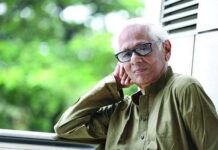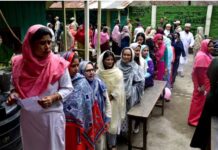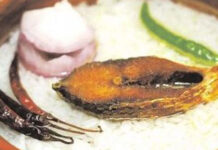M. Shahidul Islam in Toronto
The tears are yet to dry from the eyes of millions at home and abroad mourning the fateful Savar tragedy when another major tragedy has struck the nation.
Unlike the over 1,000 feared deaths — 819 bodies recovered till Wednesday — from the rubble of the Rana Plaza complex in Savar that collapsed on April 24 due to an alleged government-sponsored call to poor workers to work inside a wobbly edifice, the ‘Motijheel massacre’ took place under the direct command of the the government’s high command.
The alleged midnight massacre around the Shapla Chattar during the pre-dawn hours of May 6 has given birth to a number of new scenarios and consequences. Hefajat leaders are preparing a lawsuit in the International Criminal Court (ICC) against the Prime Minister and her cohorts while threat of revenge has been uttered by responsible leaders of Hefajat-i-Islam Bangladesh (HIB) from within.
HRW pre-warning
Human rights watchers across the world have already begun to conclude that an unprecedented atrocities by over 10,000 strong police and paramilitary forces has caused over 2,000 deaths and injured another 2500 Hefajat activists who were either on sleep, or on prayers following an exhausting day of protests on May 5 when reportedly over 3 millions of HIB followers gathered in Dhaka to attend their pre-scheduled congregation. For weeks before what now seems to have turned into the most horrific incident of mayhem in Bangladesh’s history since the March 25, 1971 crackdown on unarmed civilians by the Pakistan Army, speculations were rife about what was about to befall the nation.
Depending on reports of various diplomatic missions in Bangladesh that armed ruling party thugs would descend on Dhaka that day in great number to create mayhem, the Human Rights Watch (HRW) warned on May 3, “With new protests planned in the coming days, the Bangladeshi government should ensure that the security forces immediately end their practice of using excessive force against protesters. The government should appoint an independent commission to investigate the deaths of dozens of protesters, including children, since began in February, and, prosecute anyone responsible for unlawful killings and use of force.”
The HRW pre-warning was based on intelligence reports from some diplomatic missions that the government had planned a major crackdown on unarmed Hefajat protesters to silence their agitations forever, it was learnt.
Independent report
What exactly happened that night may be a subject of debate and introspection for months and years to come, but the Asian Human Rights Commission (AHRC), an independent rights watchdog, summed up the massacre in its initial report on May 6 that reads:
“News reports from Bangladesh allege that a series of attacks on demonstrators have taken place, at around 3am today, May 6, 2013. The extent of the injuries and death is difficult to be ascertained at the moment. The Daily Star, a Bangladeshi newspaper, gave the figure of deaths as 5. However, several internet reports have mentioned that the number of deaths could be as high as 2,500 or more. Pictures of dead bodies have also been distributed over the internet. Major news channels in Bangladesh have been silenced. Two private television channels that were showing live pictures of the attacks upon the demonstrators were immediately closed down. All forms of public gatherings, rallies and protests have been prohibited until the midnight of May 6.
It is widely believed that the post- and pre-massacre measures — such as imposing section 144 and the cutting off electricity supply around Motijheel prior to the massacre — were designed to perpetrate the killings and transport and hide dead bodies from the spot beyond public or media watch.
HIB version
The Holiday had the opportunity to talk to one of the senior HIB leaders on condition that his identity would not be revealed. He has confirmed that the initial estimate by the HIB’s media cell about the number of deaths from the pre-dawn crackdown in Motijheel was about 1,000; a figure officially confirmed by Ahlullah Wassel, chief of the HIB’s media cell. “As reports of more deaths and injuries poured in, the estimated death now stands at 2300 and the number of injured at 2900 (as of midnight, May 7, 2013)”, said the HIB leader.
This correspondent was then referred to what the HIB leader said HIB’s Chief Security Adviser (CSA), and, whose antecedent was revealed as a former officer of the Bangladesh armed forces. Upon contact, the CSA sought an assurance from this correspondence that his phone number would not be revealed and his name would remain anonymous. Agreed, the CSA said his outfit (HIB) has had some prior information about a likely government crackdown, but not to the extent it had happened.
“Our people were first blocked from entering Dhaka in the outskirts and, prior to that, transports were made unavailable in many districts by government-instigated strikes called by transport owners. But half of our estimated three million people were already in Dhaka and its outskirts by May 3. As people started moving towards the venue after Shapla Chottor was allocated in late noon, police blocked their way in eight places in and around Motijheel, pitting our activists to engage in a showdown with the police in which so much of teargas were lobbed that the victims were compelled to create fire on the street to neutralize tear gas impact.”
These are fires being portrayed by the government as the acts of arson and vandalism committed by HIB activists and for which ruling party leader Syed Ashraf declared that, “They (Hefajat) would never be allowed to come to Dhaka. We’ll not allow them to come out of their houses either.”
When response was sought from the CSA about Syed Ashraf’s threats, the CSA said, “Our top leaders have had a policy not to indulge in any violence but that policy has now changed.Asked why, the CSA broke into tears and said, “As a soldier, I will take revenge of my innocent brothers’ deaths, at any cost. We will not respond with bricks and stones anymore.”
ICC lawsuit underway
This correspondence was told that the HIB has begun to form committees abroad after this massacre and a competent lawyer has been hired to prepare a lawsuit against Prime Minister Sheikh Hasina and her accessories (under-command) in the International Criminal Court (ICC) for mass killings and crimes against humanity by relentlessly ordering slaughtering of unarmed HIB and other opposition protesters.
When contacted, the lawyer too requested anonymity and said he is working on such a lawsuit and specific evidence are being received which seems convincing to him. He said the lawsuit will be initiated pursuant to Article 2 of the 1948 Convention on the Prevention and Punishment of the Crime of Genocide (CPPCG), and, all other relevant laws and treaties that followed since.
He added, “We seem to have a strong case as the definition of genocide is now wide and encompasses murder by a government of people due to their national, ethnic, racial, or religious group membership.”
The lawyer further said, “Since February 28, nearly 3,000 unarmed protesters have been killed by Bangladesh security forces, of which over 100 deaths occurred within 48 hours on March 1-2. Now that thousands more have been slaughtered within two hours on May 6, these crimes fall under the definition of genocide and the Bangladesh government stands accused of violating all the international treaties relating to human rights. It’s time this madness is censored by the global community.”
UN and the USA
Meanwhile, the UN Secretary General, Ban Ki Moon, has voiced his concern over the ongoing killing of unarmed protesters in Bangladesh and requested the government to sit with religious and political leaders while the US Ambassador to Dhaka, Dan Mozena, has cautioned that all groups and individuals have rights to protest; insinuating that the use of brute force against unarmed protesters constitutes violations of domestic and international laws.
As the global outcry gets louder, these unintended consequences come at a time when the nation remains ungovernable due to incessant strikes and violent agitations and the government’s undeterred intent to kill as many unarmed people as needed to cling onto power indefinitely. Bangladesh also seems to be having a tryst with the destiny as it struggles to decide whether to live with democracy by accommodating all shades of opinions, or allow a virtual one-party rule to decide the fate of its 165 million people. Time for that decision is now or never.
Source: Weekly Holiday










Doubts are haunting in the minds of common people about who actually are conntrolling the affairs of the govt. In the wee hours of May 6, many are doubtful that undefined people in the garb of BGB,RAB etc were also active in the shooting spree. Pictures also showed splashes of blood streaming on the street branching from Shapla Square. Whose blood was it all and why did the DCC had to wash away those patches of blood early in the morning? Besides, while we saw a news in scroll on Ekushey TV that 15/16 journos were beaten and driven out of the periphery of AL central office before the shut down bookshops and other footpath shops were set ablaze. Several pictures also showed how a group of ‘lathials’ were beating stray Hefazat men while they were squirming on the ground. But the govt’s stance on these excesses is being slighted by responsible leaders of AL, thickening even more doubt about what actually happened on that fateful night.